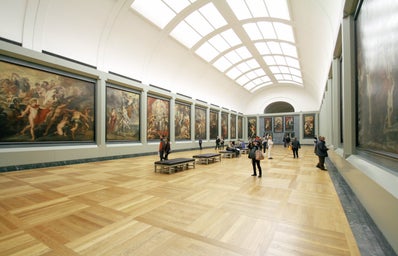Choosing to display the portraits of Hassan Hajjaj and Chantal Joffe as its first exhibitions welcoming back art lovers shows a recognition of passing time and simplistic power, on the Arnolfini’s part. The two collections moved together with an unlikely, accompanying grace – a stark juxtaposition in their composition and style highlighted their shared gravity found in an unadulterated self-assurance of the subject, all while honouring their cultural and artistic influences.
In ‘Dakka Marrakchia’, Hajjaj shows the partnering of traditional Arab dress brazen with luxury western logos, darned by Moroccan women in dominating poses – a battle-cry against western Arab stereotyping. The photographer works from low angles, having the subject look down on the viewer with a sense of allure. The women, mostly strangers Hajjaj met in the streets of Marrakech, exude a sophisticated mysteriousness, their bold kaftans balloon with the wind as they gather on motorcycles against sandy walls, acting as a vibrant motif for urban sisterhood.
Around the gallery corner, there is a second photo collection, ‘My rock stars’, an ongoing portrait series of international creatives Hajjaj finds inspiring and wants to celebrate. From spoken-word artists to capoeira masters, they are all based in the UK but from recently migrated families – putting an emphasis on the multiculturality of Britain and its creative scene. The artisans sit proudly, against loud fabric backgrounds, wearing a mixture of contemporary clothing and motifs from their ancestral homes.
Creative power and autonomy shines through the images, rich with colour and emotion. Hajjaj’s vibrancy is instrumentally used to accompany the vibrancy in his characters, and their celebration of personal and non-western culture.
Following suit, Joffe uses her portraits almost to record moments in difficult times as a way to control it, or even challenge its passing. This is captured within her intimate relationship with her daughter Esme, who’s image we see from infancy all the way to her sixteenth birthday celebrated in lockdown, in the series ‘For Esme’. In a more cutting collection, ‘Love and Squalor’, we see snapshots of Joffe’s illness in 2019 – with mother repeatedly lying helplessly in her bed, while daughter sits some meters away on her laptop, playing the role of patient carer. Her imagery, particularly those of herself crouching away from the viewer while bathing, echo those of French Impressionist Edgar Degas, contorting her flesh in scribbles of bright pastels, creating an uncurbed yet unknowable persona.
She defies to capture her subjects gracefully, but rather disjointedly, almost looking uncomfortable. Be it Esme caught from an awkward angle, rarely making eye contact with the painter with teenage passiveness, or Joffe herself, reclining stiffly in a bathtub, reading. Her mixture of squished and elongated proportions, created on canvas with large brushstrokes and thick layers of paint, causing the lines to bleed, add an extra spark of woefulness to the compositions, confronting an expectation of romanticised intimacy and perfection of the female body, both young and old.
In a third collection, ‘Painting Self, Painting Others’, Joffe monitors the changes in her own appearance the months following the ending of her relationship with Esme’s father. They seem critical, examining and painful. During the early winter months, Joffe’s image is distorted with harsh black strokes, appearing monstrous, yet this softens as the months go on, communicating a sense of relief through technique.
It seems almost impossible for the two artist’s methods to diverge even more – Hajjaj’s bright, photographic portraiture conjures a feeling of celebration and pride in his rich Moroccan ancestry, while Joffe’s sombre colour palette and violent brush strokes creates disjointed figures with an air of awkward intimacy. Nevertheless, these two styles must pride themselves in giving off an air of celebration of power, artistry and reinvention.



